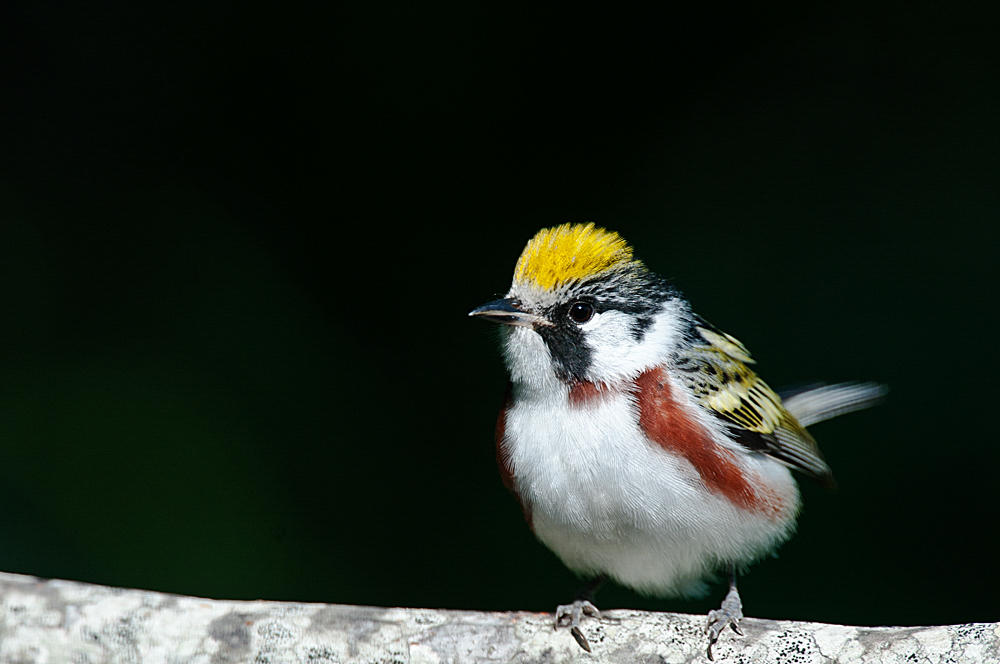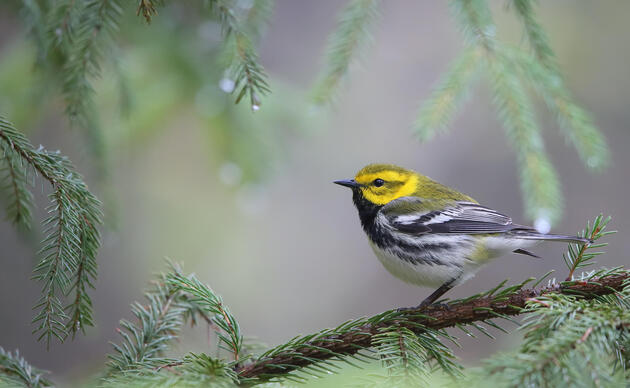Our Forests are a Treasure
Each spring, millions of migratory birds fly back to the Atlantic Northern Forest to breed and raise their young. Our region is a globally significant resource for neo-tropical migratory birds, and is among the highest in diversity for breeding birds in the lower 48 states. Of course, bird habitat is just one of many ecosystem services our forests provide. As humans, we rely on them to provide clean air and water, flood mitigation and the scenic beauty and recreational opportunities that draw tourists from the cities and enhance our quality of life.
Many our native forest birds thrive here, at the core of their global breeding ranges, but others face dramatic long-term population declines. Today, the habitat loss, degradation and fragmentation responsible for declines are interacting with the growing threat of climate change. Warming temperatures, changing precipitation patterns and increasing weather extremes, such as more severe storms and longer droughts, are taxing the forest wildlife and ecosystems (Rusted et al 2012). Audubon Vermont’s Healthy Forest Initiative addresses climate change, among other threats to birds, by working to maintain forest cover, keep forests working, and to make exemplary forest management common practice in the woods. Because of our legacy of working at the confluence of science and management, and our strategic partnerships with landowners and professional foresters across the Atlantic Flyway, we are in a unique position to make a positive difference for birds in a rapidly changing environment.
What does climate change mean for Vermont’s forests and forest birds?
It is difficult to comprehensively predict the impacts of climate change on forest ecosystems, due to the complexity of the ecosystems themselves. What we do know is that the changes we are already seeing – and the much more dramatic changes that scientists predict – could profoundly impact our forests and the wildlife and people that depend on them.
We are already seeing:
- Warming temperatures (1.8*F over the last century) and shifting precipitation patterns (more precipitation on average, less snow, more rain, more frequent severe storms, and longer droughts (Rusted et al. 2012)
- Northward shifts in birds’ breeding ranges by hundreds of miles.
- Early spring. Trees leaf out earlier (Wilmost and Simmons 2009), changing the predator-prey interactions among leaves, leaf-eating insects, and the birds that depend on them for breeding season food. Human activities such as maple sugaring are disrupted.
- Range expansion of native and exotic pests and pathogens, such as hemlock woody adelgid (Fitzpatrick et al 2012) that threaten forest health in general.
By the end of this century, we can expect:
- Temperatures 9*F warmer
- Longer, dryer growing seasons
- Snow cover will decline or disappear
- More frequent, more severe storms
- Replacement of suitable habitat for northern hardwood forests by habitat for oak-hickory forests
- Disappearance of spruce-fir habitat and high-elevation birds (Rusted et al 2012)
As temperatures rise our woods may experience changes that negatively affect growing conditions for our native trees and plants. Additional interacting factors such as extreme weather, fragmentation, acid rain, ozone pollution, and the introduction of exotic invasive pests and pathogens are stressing our forests at the same time, challenging their ability to bounce back from disturbance.
New England’s birds are already moving north by hundreds of miles in response to warming temperatures. While shifts in breeding and wintering ranges are not necessarily problems in and of themselves, they can propagate changes in intricate food webs, impacting ecosystem resiliency and potentially resulting in the loss of species, productivity and other ecosystem functions.
As with the proverbial canary in the coal mine, our birds’ drastic response to warming is an important warning. Temperature patterns are dynamic, and they have fluctuated significantly over geological time. The current rate of change, however, is unprecedented. Current and expected changes threaten our ecosystems, as they are happening too quickly to allow for the evolution of long-lived organisms such as birds and trees to adapt.
Strategies for climate change mitigation and adaptation
Keeping Forest as Forest
Maintaining forest cover (or reducing deforestation) is among top recommendations from experts working to curb climate change at the state (GCCC), national (Ryan et al. 2010) and global levels (Stern 2007). Preventing deforestation is among the most cost effective strategies to reduce carbon emissions worldwide. As a mostly forested region, the Atlantic Northern Forest can contribute significantly to climate mitigation by preventing the conversion of forestland to other uses.
Keeping forest as forest is also among our best tools for adapting to the inevitability of climate change. Vermont’s migratory songbirds need large blocks of connected forest here in their breeding range, as well as along migration corridors and in their southerly wintering habitats. The Flyway-wide connectivity that has always been important for interior-nesting birds is becoming increasingly important for forest health in a warming world. A network of intact forest that captures the full range of biological and physical diversity will be most resilient, for example facilitating the movement of plants and animals north as conditions change.
The Healthy Forest Initiative supports forest conservation by:
- Building a land ethic by educating landowners and other Vermonters about the value of their woods for birds and other ecosystem services.
- Advocating for permanent land conservation using conservation easements.
- Advocating for policies that make forest conservation and management affordable (such as the Use Value Appraisal Program and funding for forestland protection under the Vermont Housing and Conservation Fund).
- Accepting timber management as a conservation and habitat improvement tool and getting involved. By providing an income flow to landowners, active management can reduce the risk of conversion. We work directly with foresters and landowners to integrate bird habitat and timber management, taking advantage of the management planning process already in place on millions of acres to achieve habitat protection and improvement on the ground.
Managing Forests with Birds and Climate in Mind
Active forest management provides opportunities to restore diversity to the woods, support breeding birds, increase carbon storage, and enhance forest health and resilience. Audubon biologists provide technical assistance to landowners and managers, helping them to understand, protect and improve breeding habitat for birds of conservation concern. Many of the strategies we promote for breeding habitat enhancement support other ecosystem services including climate change mitigation and adaptation as well. For example, the large downed logs that host insects (bird food) and provide drumming sites for ruffed grouse, nest sites for Canada warbler, and perches for ovenbirds, also store carbon, retain soil moisture and provide habitat for other animals. Downed wood can protect seedlings and saplings from herbivory, for example by deer, and the moisture they retain can aid germination. Structural retention in general enhances carbon storage as well as wildlife habitat. Refuges such as tree cavities and hollow logs can provide shelter in the coldest winter storms and shade and moisture on the hottest summer days, helping animals to weather extreme conditions. Contact Audubon Vermont for a full list of stand-level management recommendations and their climate mitigation and adaptation benefits.
Building strategic partnerships
Management options are developed through a collaborative and interdisciplinary process, and are meant to be adapted as new information becomes available. The “Foresters for the Birds Project”, which began in 2008 as a partnership between Audubon Vermont and the Vermont Department of Forests, Parks and Recreation, has grown into a network of biologists, foresters and landowners throughout Vermont and the Atlantic Flyway, who are interested in integrating timber and bird habitat management.
This award-winning partnership has been lauded for changing the conversation between the conservation and forestry community by seeking – and finding - common ground. True and ongoing collaboration is allowing us to develop management options that are based on science, vetted by practical professionals, and tested on the ground. We are available on an ongoing basis to our partners, and are committed to seeing and monitoring habitat improvement on the ground. Perhaps most importantly, we are building trust among constituencies that have sometimes sparred.
Landscape and flyway level conservation planning
The Audubon network is organized around the hemispheric flyways traveled by our birds each spring and fall in order to offer a seamless web of conservation for all birds.
Vermont’s migratory songbirds need large blocks of connected forest here in their breeding range, as well as along migration corridors and in their southerly wintering habitats. Examination of a property’s landscape context is the first step in a Forest Bird Habitat Assessment, one of our key landowner outreach tools. The Flyway-wide connectivity that has always been important for interior-nesting birds is becoming increasingly important for forest health in a warming world. A network of intact forest that captures the full range of biological and physical diversity will be most resilient to change. Connectivity will also allow for the migration of wildlife species that do not have the advantage of flight.
New science is emerging about how to make our landscapes as resilient as possible to climate change. But often the links between academic science and practice are weak. Our role at the intersection of science and management can help us to understand and disseminate cutting edge knowledge. Within Audubon, new concepts such as microclimactic buffering can be built into the models we use to prioritize landscapes in the state and flyway.
How you can help, right now
Donate to Audubon
Help secure a future for birds at risk from climate change, habitat loss and other threats. Your support will power our science, education, advocacy and on-the-ground conservation efforts.
Visit Audubon
It's always a good time to visit the Audubon Center. Trails are open to the public year-round. Visit us daily from dawn until dusk! Donations are appreciated.
Events
Adults, preschoolers, foresters, photographers, sugarmakers and families will all find opportunities to connect with nature.





